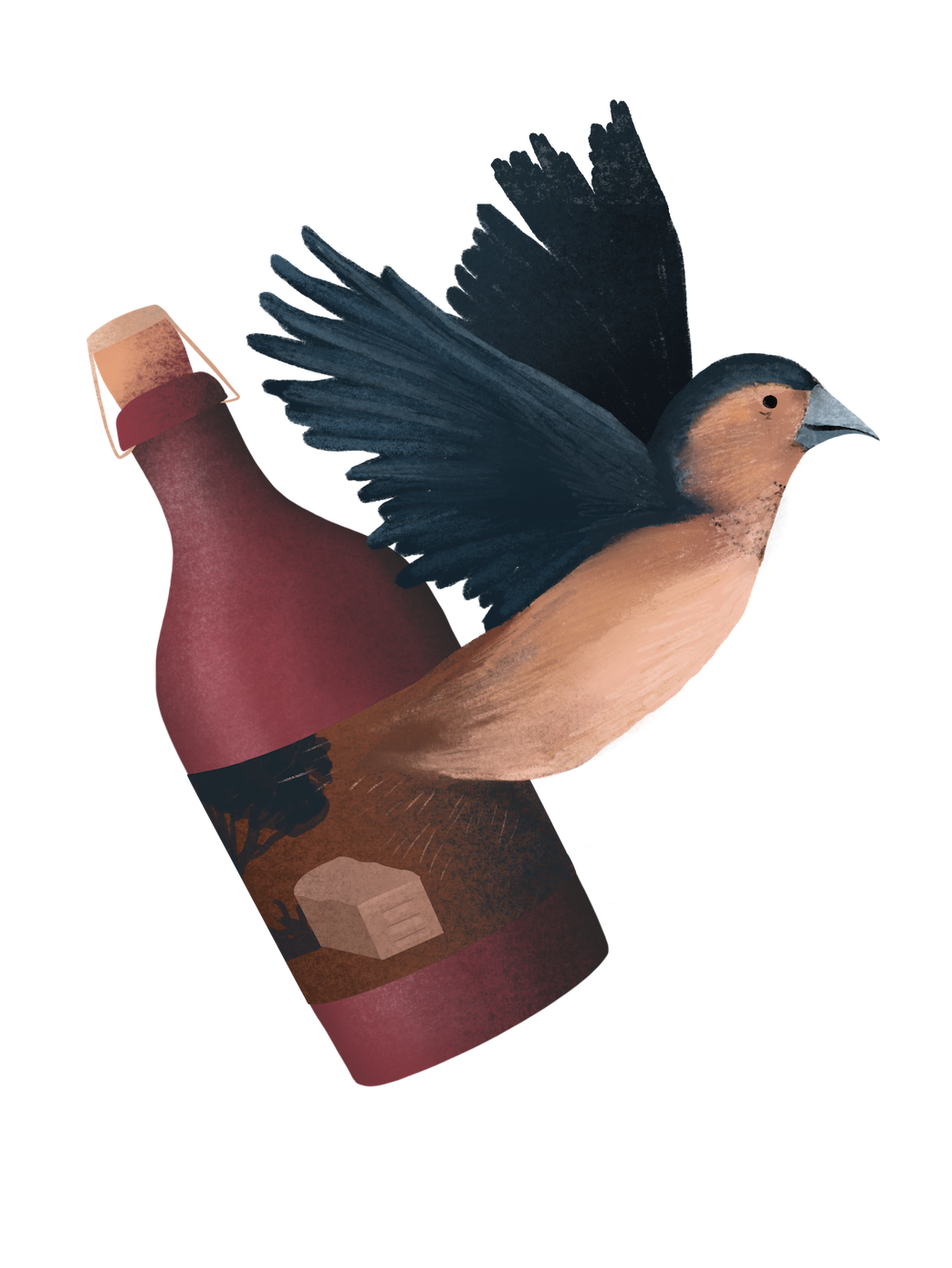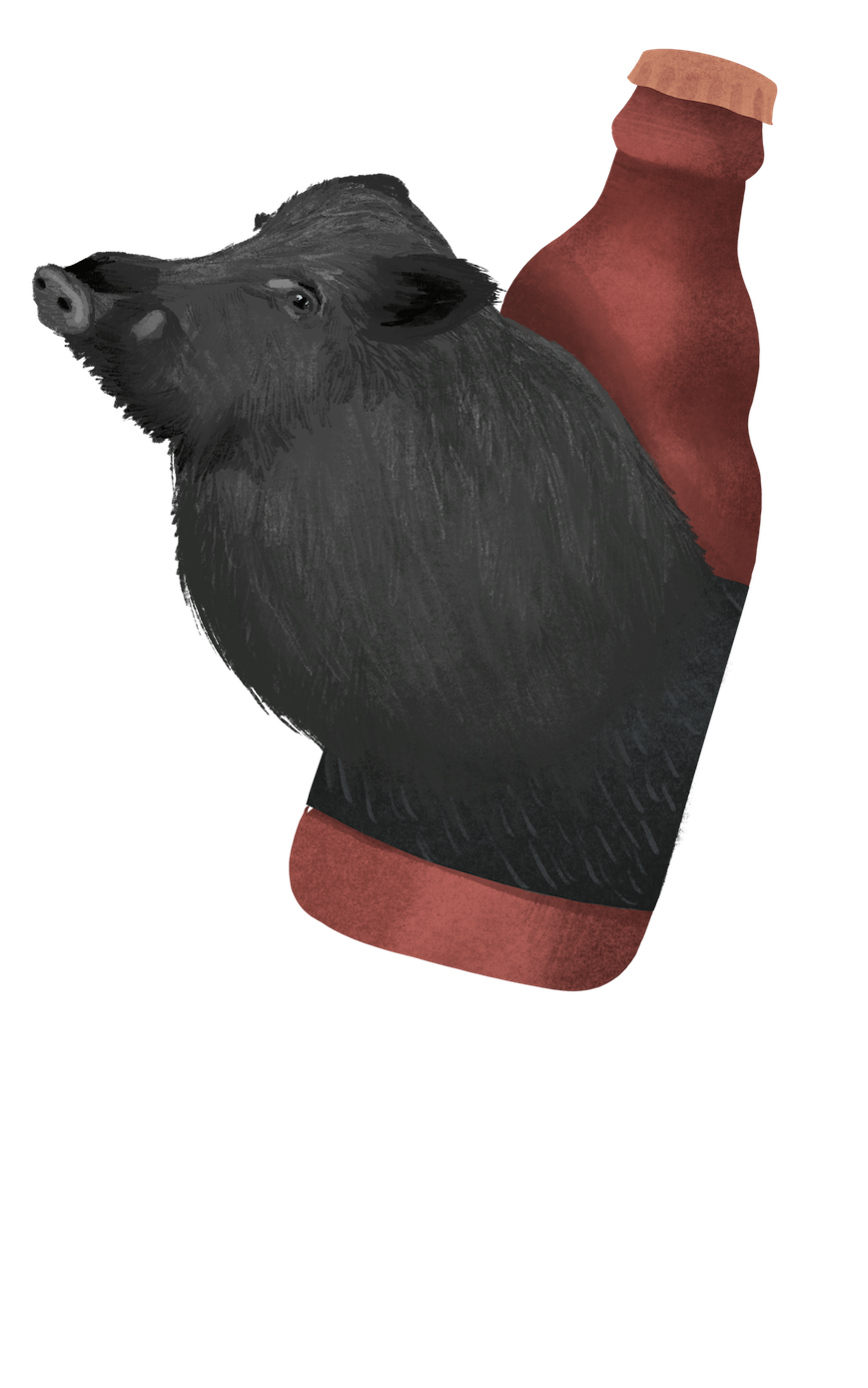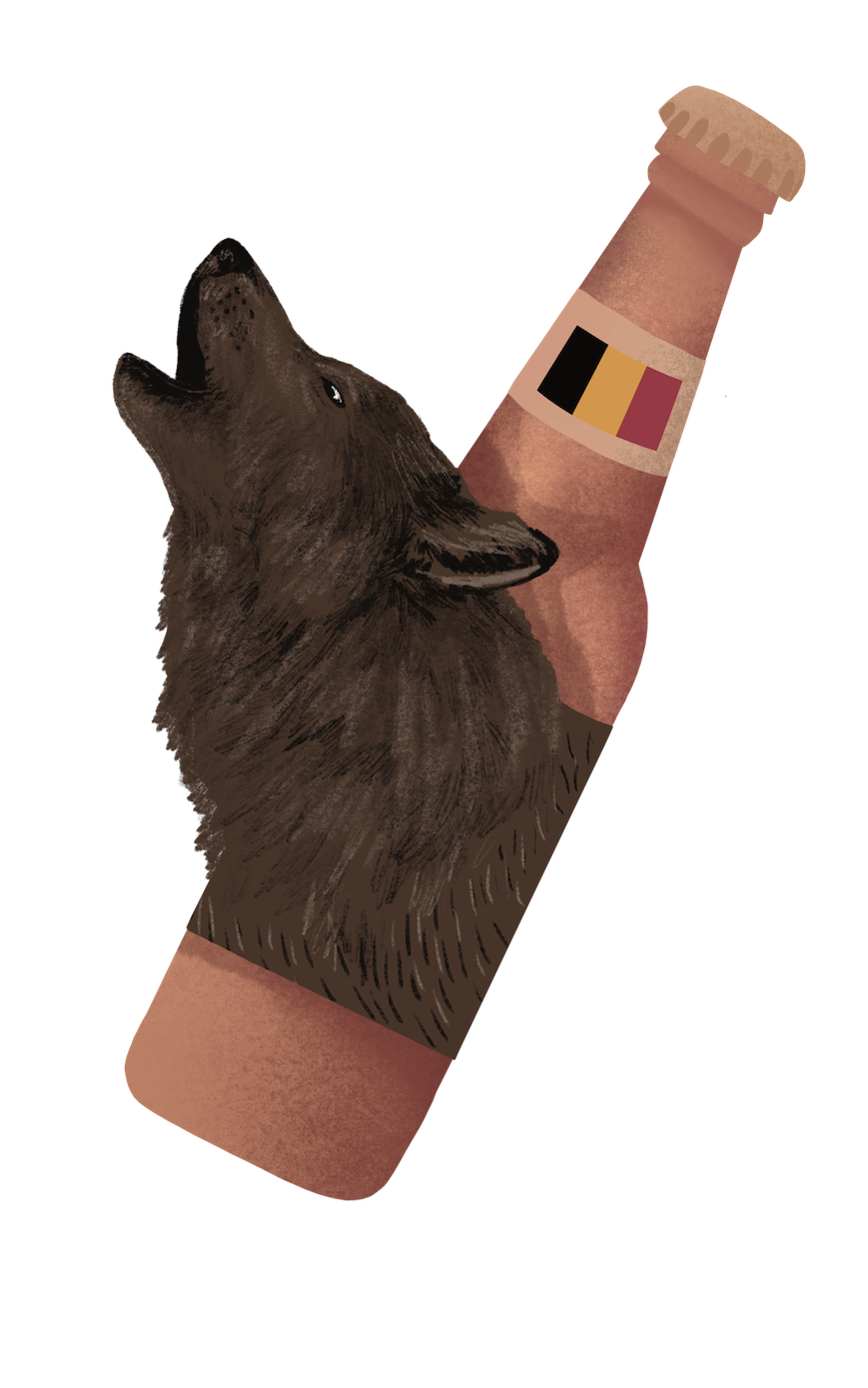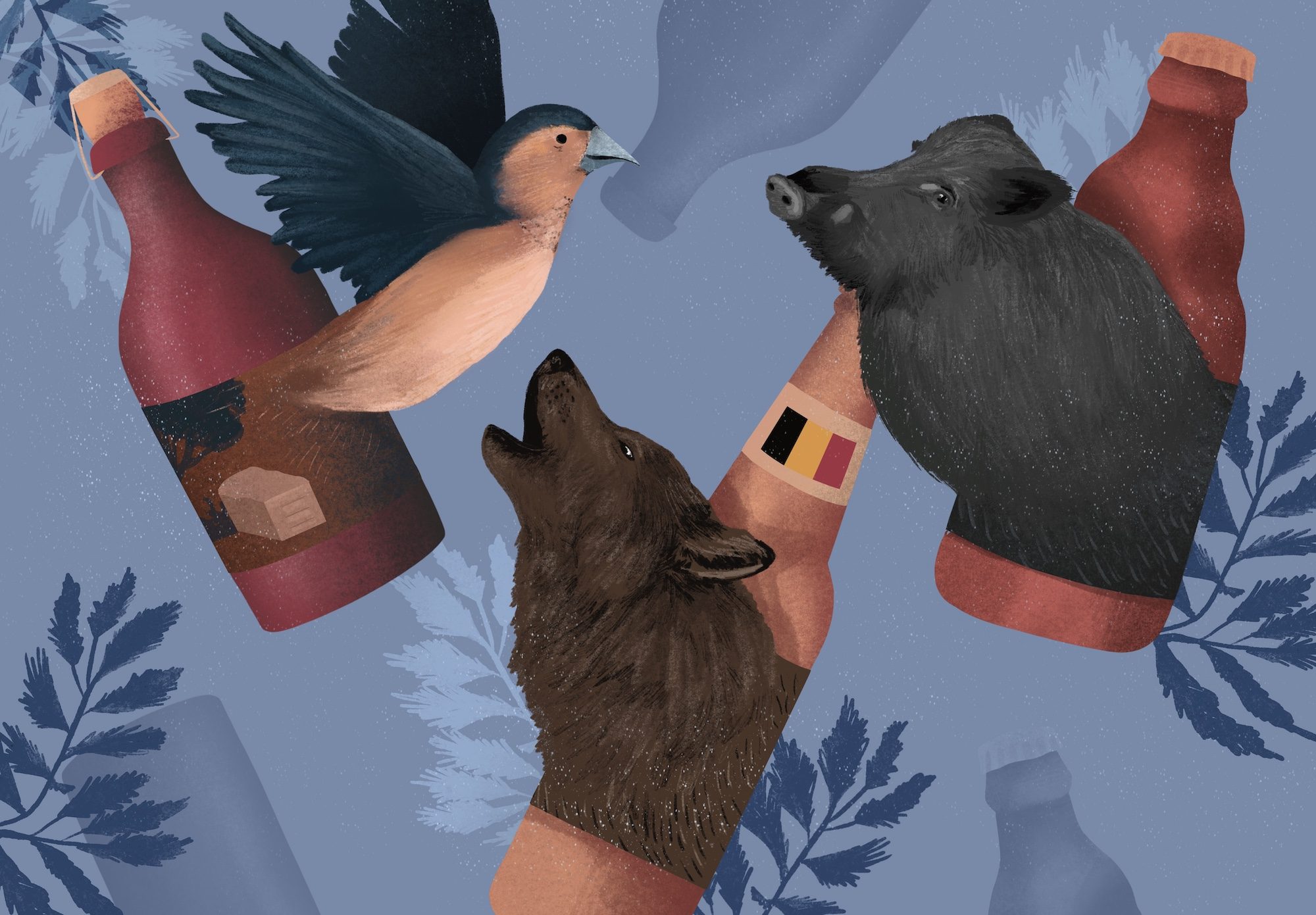Words by Breandán Kearney
Illustration by Flore Deman
Edited by Oisín Kearney & Ciara Elizabeth Smyth
In 2019, the first wolf was spotted in Belgium in over a century. Naya was a slender but powerful female wolf with grey and beige fur, small, triangular ears, and curious yellow and blue eyes, who had travelled 500 kilometres in ten days from Mecklenburg-Vorpommern in Germany to the Limburg province in the northeast of Belgium. Naya was soon joined by August, a male wolf who became her companion.
On 10 May 2019, footage of Naya captured by the Flemish Landscape Agency showed that she was pregnant. August was seen fetching and carrying food. Government and conservation organisations expressed their excitement about the new family. Belgians claimed Naya as one of their own, her appearance making headlines in national newspapers and television reports. The indigenous wolf population in Belgium had disappeared in 1868. After a long absence, the wolf was back.
But two weeks later, pregnant Naya went missing and August stopped fetching food. The Flemish Agency for Nature and Woods confirmed “with near certainty” that Naya and her unborn cubs were dead, most likely, in their view, having been killed by humans in suspicious circumstances. To this day, the mystery of her disappearance has not been resolved.
Wolves are not the only animals to have suffered in Belgium. As in other countries, habitat loss and the degradation of ecosystems has become a major threat to Belgium’s wildlife. The over-extraction of water has been exacerbated by increasing droughts due to climate change. Pollution is getting worse. The introduction of alien species has upset ecological balance. In addition, human treatment of animals has been shameful: whether they endure the side effects of our consumptive use of natural resources, agricultural intensification, or growing urbanisation; or whether they suffer directly, as Naya and her cubs are suspected to have done at the hands of human hunters.
Maybe it’s because of this complicated subconscious guilt that Belgians have felt the need to celebrate animals on their beer labels. Or perhaps it’s the shared behaviours, characteristics, and iconography of some animals with our their selves—or at least versions of themselves that they’d like others to see—that has made them useful to Belgian breweries in marketing. More than monks or abbeys or saints, animals on bottles of beer in Belgium have come to represent manifestations of local or regional identity. Animals are rich in meaning as symbols, and they can be reflective of the strengths, faults, mystery, and pride of those that produce them.
The Flemish lion, black and yellow with red tongue and claws, takes centre stage in the logo of Brouwerij Verhaeghe, appearing on all of their beers. The Walloon rooster adorns the Belgian Pale Ale Le Coq (6% ABV), brewed by beer company Brasserie Gosselin F. at Brasserie de Blaugies. Indeed, it’s difficult to scan the shelf of a Belgian bottle shop without coming across an animal, whether it’s the iconic Orval trout, the delirious pink elephant of Huyghe, the Golden Dragon of Van Steenberghe, or the Belgian draught horse of Palm. The wolf itself, linked to the Latin nomenclature of the hop plant—“humulus lupulus”, or “small humble wolf”—features on the beer labels of Brasserie Lupulus in Gouvy, on the logo of Brouwerij Wolf in Aarschot, and on the Waase Wolf Amber Ale (6% ABV) from Brouwerij Boelens.
Animals remain so ingrained in the minds of Belgians that they have come to dominate the visual identity of arguably their most important cultural product. But just what do animals tell us about the history of the region in which those beers are produced? And what do they say about the personalities of the people that produce them?
The Belgian government agencies that protect birdlife own or manage as many as 400 nature reserves, covering 17,147 hectares of land. The avifauna of Belgium includes a total of 466 bird species, one of which is the “Steenuilke”, an endangered species of small owl indigenous to the Flemish Ardennes which now gives its name to a beer produced in collaboration between Brouwerij De Ryck in Herzele and their local conservation authority. The beer showcases three herbs and spices from the habitat of the Steenuilke in the Flemish Ardennes where the brewery is located—sweet woodruff, angelica, and blackthorn—delivering a soft herbaceous character to the beer. It’s an attempt by De Ryck to promote and protect their indigienous mascot.
Steenuilke is a Belgian Blonde Ale of 6.5% ABV which features a woodcut illustration of the little owl on the beer’s label. Some believe this label is iconic. Others have compared it to a QR code. “It’s a rare bird, so it needs a rare label,” says Miek Van Melkebeke who works in sales and marketing for her family brewery, De Ryck.
The brewery had originally been named after a different bird. Van Melkebeke’s great great grandfather Gustaaf De Ryck learned about brewing in the German city of Bremen at a brewery called “Zum Goldenen Adler” or “the Golden Eagle” so when he returned to Herzele and opened his own brewery in 1886, he gave it the equivalent name in Flemish: Brouwerij De Gouden Arend. He subsequently changed its name to the family name De Ryck to avoid associations with the Reichsadler “Imperial Eagle” of both the Weimar Republic and the Third Reich. Then in 2011, Brouwerij De Ryck put a golden eagle graphic on a new beer, a classic Belgian Tripel using citrusy hops, the Gouden Arend Tripel, brewed for the 125th anniversary of the brewery. The use of the eagle was a nod to the early days of great great grandfather Gustaaf. Family heritage matters as much to the De Rycks as other Belgian brewers.

Brouwerij Eutropius produce a beer which celebrates not just a particular species of bird, but an eccentric Belgian bird sport which at one time defined rural life around the town of Menen in West Flanders where the brewery is based. Vinkenier, first brewed in 2013, is a 10.8% ABV Belgian Strong Pale Ale, named for “vinkenzetting”, a Flemish activity in which male common chaffinches are made to compete for the highest number of bird calls in an hour. The sport traces its origins to competitions held by Flemish merchants in 1596 and is considered part of traditional Flemish culture. There are over 13,000 enthusiasts, called vinkeniers, breeding 10,000 birds every year.
The label of the beer depicts a row of small boxed-off cages facing their owners, each one housing a single male chaffinch lined up six feet apart along a street. A timekeeper can be seen on the label standing behind the vinkeniers. Every time a bird sings a correct flourish to the owners’ call—most often transcribed as “susk-e-wiet”—a tally mark in chalk is made on a long wooden stick. The bird singing its song the most times during one hour wins the contest.
In 2007, The New York Times reported from Belgium that one chaffinch sang a record 1,278 susk-e-weits in one hour, and the owner was later accused of doping the bird with testosterone. After another contestant sang exactly the same number of calls in three rounds, the boxed-off cage was opened and a mini CD player was discovered within. Animal rights activists oppose the sport, arguing that the birds are brainwashed to sing more than is natural or healthy. They also allege that some birds are blinded with hot needles in order to reduce visual distractions.
The brewers at Eutropius, Wouter Vermeersch and Barbara Pratz, have made the Vinkenier the strongest of all the beers in their range, zealots in celebrating and preserving one of the most eccentric and controversial of Flemish sporting customs, irregardless of whether others have heard of the sport, or what they think of it.
A wild boar features on the labels of each of the Ardennes Saison, Ardenne Stout, and Bastogne Pale Ale bottles as well as the Ardenne Wild, Ardenne Wood, and Troufette ranges, all beers produced by Brasserie Minne—formerly called Brasserie Bastogne—who are located between Somme-Leuze and Marche-en-Famenne in the heart of the Belgian Ardennes.
The Belgian Ardennes was once a vast ancient forest known as Arduenna Silva. In mythology, it was home to Arduinna, a goddess thought to be represented as a huntress riding a boar around the extensive forests, rough terrain, and rolling hills of the Walloon valley (there’s also a beer called Arduinna produced by Brasserie Saint-Monon, a Belgian Pale Ale of 5.5% ABV which features the head of the goddess on its label). There are parallels between Arduinna and the Roman goddess Diana, a patroness of the countryside and of hunting.

Boars once flourished in the Ardennes, and are still regarded by people who live there as a symbol of the area, revered for their strength and virility and their symbolism of forest life and its mystical properties. The animal is used in Minne’s branding for their regional pride: nothing is more Ardennes than the boar and no beer is more Ardennes than one that bears the boar on its label. From a marketing point of view, the animal’s associations with fairytales is a useful one. Folk tales have long been used to help sell beer in Belgium and owners Philippe and Catherine Minne are nothing if not good storytellers. Unfortunately, viruses have been as cruel to the animal recently as they have to humans: an outbreak of African Swine Flu swept through the Ardennes in the last two years, killing at least 833 wild boars and causing the infected forests to be closed to hikers and cyclists.
Another wild animal that shows up again and again in Belgian beer is the goat. In 2017, Brasserie de la Lienne released a beer called “The Belgian Goat”, a Belgian Strong Golden Ale of 8.2% ABV that was aged in barrels of the Walloon whiskey brand “Belgian Owl”. Brasserie de la Lienne, located since 2013 in an old sandstone quarry in the Liège hamlet of Reharmont have chosen the animal for their logo because it is featured in a famous local legend.
The story goes that Baron Rambert met the fairy Lienne beside the river at Grimbiémont, and after falling in love, Lienne gave Rambert a golden goat. When Rambert would shear this goat and use its golden hair to pay for servants, clothes and food, its fleece would immediately grow back. After five years, the fairy Lienne disappeared into the river and Rambert never saw her again. The golden goat remained, passed down through Rambert’s lineage until a plague wiped out his whole family and silhouettes of a goat were seen rising into the sky. The river, and subsequently the brewery, took the name Lienne. Because of regional pride and established distribution systems, Belgians tend to drink local, and those who own the legend can claim to brew the true local beer.
Raf Souvereyns has also placed a goat at the centre of each of his labels to expound the terroir of his spontaneously fermented beer. Based near the city of Hasselt in the province of Limburg, Souvereyns buys wort from Girardin, Lindemans, and De Troch to blend various Lambics into products which sell under the brand, “Bokke”, a Flemish term originating from the name “Bokkereyer” which references the billy goat riders or “Buckriders” of Limburg folklore.
The legend is so popular that another brewery in Limburg, Brouwerij Cornelissen, own the rights to the name “Bokkereyer” for their Amber Ale, but after some discussion, an arrangement was reached between Souvereyns and Cornelissen on what names could and could not be used. The way that Souvereyns ages, blends, and packages his Lambics—much of which has been influenced by time working at Limburg wineries—has been described not as “Méthode Champenoise” or “Méthode Geuze”, but owing to his location and branding, as “Méthode Goat”.
The Bokkereyers rode through the sky on the back of flying goats provided to them by a demon. In the 18th century, thieves and criminal bands calling themselves Bokkereyers launched raids across the province of Limburg where Souvereyns is based, destroying peaceful communities and farms. In using an animal often seen as a harbinger of doom, Souvereyns is hoping to equate the dangerous, lawless, and perhaps exciting history of his home place with beers involving fermentations which by their very nature are wild and uncontrollable.
There’s plenty of bovine marketing in Belgian beer, some of which is intended to portray strength, power, and masculine virility, such as in the case of “Den Bruinen Os” or ”the Brown Ox”, a dark ale brewed in Bruges and blended with Lambic from Timmermans to create the Bourgogne des Flandres brand. Others tell us about important moments in a village’s history. Brouwerij Cnudde brew their “Bizon” Oud Bruin in Eine, the name and image on the labels commemorating the liberation of their city in the Second World War by a US regiment whose coat of arms contained an American bison.
One set of beers named after bulls and inspired by the visit of different Americans is the Buffalo range of beers from Brouwerij Van Den Bossche in the East Flemish village of Sint-Lievens-Esse. In truly confusing Belgian style, however, all the Buffalo beer labels feature an image of a man riding a horse. In 1907, Buffalo Bill, an American bison hunter, brought his touring Wild West Circus to the village where the Van Den Bossche brewery was located. It’s said that the brewer responsible for stirring the brewery’s boiling wort didn’t want to miss out on seeing the circus and ran over to have a look at the vaudeville shows and stage productions romanticising the American frontier.
After the circus performance, the brewer returned, and without saying a word, let the wort cool and pitched the yeast as usual. However, because he had been gone for longer than anticipated, the wort had undergone a heavier boil than usual, with more evaporation resulting in a denser wort with a higher gravity of sugars. When it fermented, it was much stronger than the beer that was intended. The resultant beer was named “Buffalo 1907” after the circus and the year it was brewed.
In 2006, Van Den Bossche re-released Buffalo 1907, a Belgian ale of 6.5% ABV with notes of caramel and molasses; together with Buffalo Bitter, a dry, spicy Belgian Pale Strong Ale of 8% ABV, and Buffalo Belgian Stout, a sweet Dark Strong Ale of 9% ABV. Then, in 2012, Van Den Bossche launched Buffalo Grand Cru, a complex, oak aged, Belgian Dark Strong Ale of 9% ABV. The image of a man riding a horse on the label harks back to the rodeo events of the travelling circus of 1907. In maintaining this branding, Van Den Bossche not only point to the influence of international events on Belgian beers, but they wear this mistake from their own history with pride, a humble brag about their ability to engineer opportunity out of error.
Other bulls in beers give us an insight into the passions and aspirations of their creators at the time of their inception. Albert Van Damme of Brasserie Piedboeuf in Jupille-sur-Meuse was a football fan and got the idea for an iconic bull on labels of his beer during a trip to Italy where he spotted a depiction of the animal on the logo of the Torino football club. His brewery launched a brand called Jupiler in 1966. It’s said jokingly that a correct pour of the beer reaches the level of the bull’s balls on the classic Jupiler glass. The origin story has come full circle, with Jupiler now the official partner of both the top division in Belgian club football—the Jupiler Pro League—as well as the sponsor of the Belgian national football team, the Red Devils. The creator of Jupiler was bullish in his pursuit of commercial success with Jupiler, now owned by Anheuser-Busch Inbev, the biggest selling beer in Belgium. Today Albert’s grandson, Alexandre Van Damme, who inherited his fortune, sits at No.1 on “De Rijkste Belgen”, an official list of the richest Belgians.
Different animals represent the different regions of Belgium for a variety of reasons: the accentuation of a region’s folklore; the pride in a niche sport championed by its local people; the deference to a key character in a story from the past; or even to mark international inspiration now adopted as part of one’s own story.
But of all the animals, perhaps it’s the wolf which best represents the national beer culture.

Like the wolf, Belgian beer has an historic lineage, a wildness in the way fermentations are often left uncontrolled, and an elegance in how it struts in Champagne bottle and chalice glass. Like the wandering wolf, Belgian beer has spread to other parts of the world where it has at times been admired for its majesty, but also where it has been ignored, or perhaps sometimes feared and attacked, for its eccentricities of flavour, or its intensity, or its cultural strangeness. Despite marketing copy which might say otherwise, Belgian beer has also undergone periods of existential threat, when breweries by their hundreds completely disappeared due to war or because styles such as Saison, Oud Bruin, and Lambic were nearing extinction.
Like Belgian brewers, wolves communicate, collaborate, and share knowledge across generations. The older wolves, as more experienced hunters, share strategies and techniques with younger wolves, passing down know-how from parent to child, maintaining a culture unique to that pack. Biologists have even observed wolves change their hunting strategies based on weather, terrain, and prey behavior, similar to the ways Belgian brewers adapt in the face of changing trends and diversifying markets. They are pathfinders, destined to continue on a never-ending journey.
In the summer of 2020, August—the former companion of the murdered wolf Naya—was joined by another wolf, a female called Noëlla. Footage from wildlife cameras soon revealed that they had paired off and produced four pups. It was the first time in 150 years that wolves had been born in Belgium. Two months previously, more wolves had arrived in Belgium. Three male wolves from France were spotted in the villages of Ebly, Xhoffraix, and Bütgenbach. At the exact same time, a male German wolf called Akela was seen roaming the High Fens, joined by another female wolf, a meeting which presents the opportunity of a second litter. The development excited environmentalists because the arriving wolves were both lowland wolves from Germany and mountain wolves from France, groups from the same species but which have not mixed for two centuries.
Earlier this year, a new beer called Naya was launched in Belgium by Brouwerij De Logt, a small brewery with a capacity of 400 litres per batch located in the municipality of Hechtel-Eksel in the Limburg province, not far from where Naya the wolf had roamed, got pregnant to August, and been killed. Part of the proceeds of the 7% ABV Belgian Blonde Ale would go to the nonprofit organisation, Welcome Wolf, with the intended goal of covering the costs of the judicial investigation surrounding the death of Naya. The bottle label features a wolf paw print.
The Naya beer is a small fundraising initiative to find justice for a wild wolf by a tiny unknown Belgian brewery, but it highlights how Belgians are keen on the conservation of old ways and the preservation of important relationships. The Naya beer speaks to an underlying resilience as a national characteristic, a gritty pragmatism in life as in beer. When wolves are hunted and killed, the species will eventually find a way to return. Because of its nature, the wolf prevails.
*



